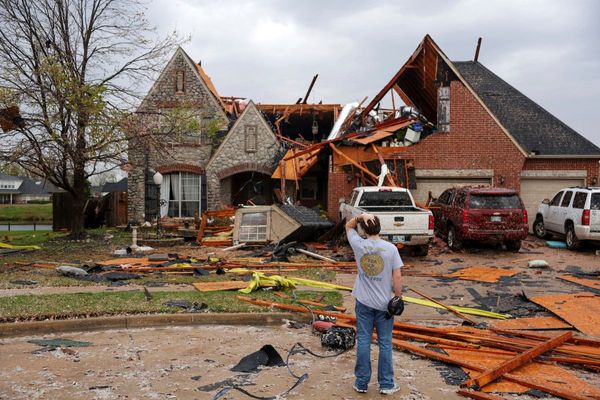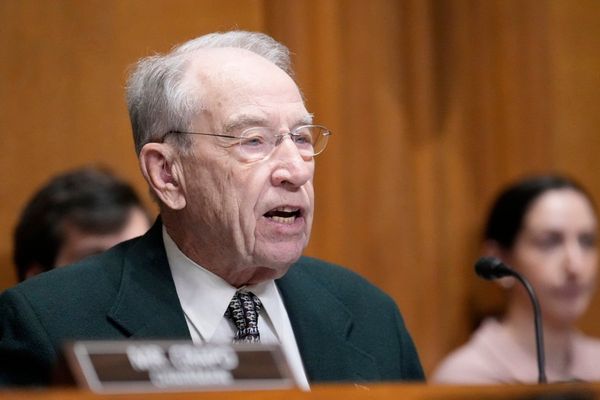From certain places on Darrel Sweet’s ranch near Altamont Pass in California's Diablo Range, the world looks no different than it did 150 years ago. Wildflowers blanket the hillside. A ranch dog named J.J. chases squirrels across a muddy dirt track. Cows stand near a cattle pond, looking out at a range of rolling hills that seem to act as a bulwark against time.
But from one of the ranch’s hilltops, it’s clear that much has changed. Towering wind turbines dot every mountain. To the west are sprawling developments in Dublin. To the south, the suburban center of Livermore.
“When you’re in downtown Livermore, you’d think this place is all developed,” Sweet said. “But it’s not.”
As cities around it have undergone explosive growth, residents say Livermore has maintained a sense of identity tied to its agricultural and ranching history. But that identity has also come into conflict with suburban development and the changing culture of the Bay Area.
Working farms and vineyards still surround the city of 86,000. An ancient ranch, part of the original Mission San Jose, is preserved in the center of town. And at Livermore High School, dozens of students continue to enroll in an agricultural sciences program — the last of its kind in Alameda County.
In the metropolitan Bay Area, Livermore stands out as a place where, as one long-time resident put it, you can find “a physicist, a rancher, and a gravel pit worker all sitting together at the bar”.
But the town is also changing. Most students enrolled in the high school’s ag program now grow up in suburbs, rather than on farms. In the past decades, Fremont, Hayward, and Pleasanton have all gutted their agricultural sciences programs.
Livermore, one of the last ag dominos to topple in the Bay Area, could be seen as proof of how the remnants of ranching culture that once thrived in this region have been pushed out to the edge of Alameda County. Or it might be an example of how a heritage industry can find a way to evolve in a modern environment.
Or, perhaps, both.
RELATED: School enrollment has plummeted across the Bay Area. So why have students in this East Bay city skyrocketed?
“A lot of people still think of Livermore as a rural community,” said Jeff Kasky, a longtime resident and curator of Hagemann Ranch, a preserved five-acre property that has been in operation since the 1800s and is now surrounded by housing developments. “We’re kind of in that inflection space.”
Hagemann Ranch, although surrounded by suburbs, hosts community events every month and functions as a haven for non-profit organizations like 4H. The ranch has goats, horses, and a number of semi-feral cats scattered between the old house, windmill, and century-old barn. A nonprofit that works with adults with intellectual disabilities regularly makes use of their demonstration garden.
It’s one of a few historic farms around the Bay Area that have carved out a niche within otherwise urban areas. In San Jose, the Emma Prusch Farm Park has introduced generations of South Bay families to horses and farm life. The Ardenwood Historic Farm in Fremont is now a living monument for agriculture’s contributions to the region.
Meanwhile, cities like Brentwood in Contra Costa County — still known throughout the entire western U.S. for its sweet corn — and “Garlic Capital of the World” Gilroy in Santa Clara County are also holding on to their areas’ historic ag traditions.
But, like Livermore, they have become outliers. In the past 40 years, the nine-county Bay Area has lost more than 200,000 acres of agricultural land to development. Crop and animal production establishments declined by nearly 50 percent between 1995 and 2015.
The torchbearers of Livermore’s agricultural heritage see the high school’s ag program as one of the keys to its preservation. At least 40 students from the high school keep their animals at a school farm near the 580 interstate — feeding, cleaning, and weighing them for the County Fair in June. Livermore’s Future Farmers of America (FFA) chapter has over 200 members.
According to Lori Porter, a teacher at Livermore High, many of the students enrolled in the classes now have no background in agriculture at all. They find their way to the program through personal interests, rather than past experiences.
“You’d be shocked by how many kids want to be involved in production agricultural, want to raise animals,” said Porter.
The program includes classes like agricultural biology and animal anatomy, as well as supervised agricultural experience. It’s not uncommon to find a student out walking his pigs at the farm after school. On weekends, students wake up early to care for their animals.
The students themselves own the animals, and bear the responsibility if anything happens to them. Joe McNealy, another agricultural instructor at the high school, said it’s a way for students to learn financial accountability, in addition to other skills.
Savannah Gratny, a senior at Livermore High, had her life direction shifted after being exposed to the program. Prior to taking classes, she had no background in ranching or farming. In the fall, she’ll be enrolling in Iowa State University to study agriculture.
To Sweet, whose kids all went through Livermore High’s agricultural sciences program, experiences like Savannah’s are a testament to the opportunities still available in the agricultural field.
“A lot of times when we were growing up we were told that there’s no future in agriculture,” Sweet said. “But people still eat food. And not all farmers are a guy with a pair of bib overalls on a tractor.”
The county and town have also taken steps to support agriculture. Measure D, passed by voters in 2000 and revised last year, put a limit on urban sprawl into open space or ranch lands. The county has a Right to Farm Policy which is intended to “support, encourage, and protect agricultural operations… within the county”. The county fair serves as a community hub.
Although much of the Bay Area is heavily urbanized, there are still tens of thousands of acres of grazing land in Alameda County alone — and more in the surrounding region. California is still the country’s largest producer of agricultural products.
Livermore toes the line between those two realities. The Lawrence Livermore National Laboratory, where scientists worked to develop the atomic bomb in the 1950s, is located in the southeast corner of town. Many of the most famous residents in the town’s history are nuclear physicists, not ranchers.
But the core of the city, for many, will always be ranching. Sweet and his family still run cattle on the ranch, although he declined to give an exact number — “asking a rancher how many cattle he has is like asking how much they’ve got in the bank,” he said.
A mile away from Hagemann Ranch, there are Jamba Juices and Taco Bells. But just like Sweet’s hillsides, the ranch itself looks much as it would have in the 1800’s — a long gravel path framed by a barn, granary, and pastures.
“This is a piece of the character of the town.” Kasky said. “The Jamba Juice is too. But it’s important to have places that tell a story of a place.”







